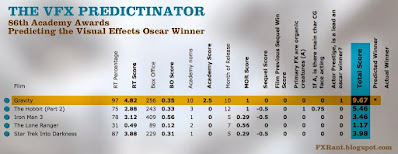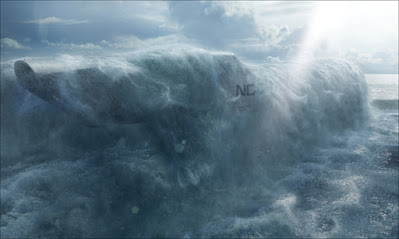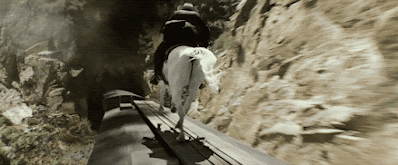update, May 2023: Since Cinefex shut down, this article had been inaccessible. I've resurrected it and reprinted it here.
Predictinating the Oscars with Todd Vaziri
by Graham Edwards, originally published on Cinefex.com, February 4, 2014
As a movie-mad Chicago kid, Todd Vaziri dreamed of being a stuntman. He never did get to ride a horse along the top of a moving train, but he did get to work in the movies – as a visual effects artist.
Todd began his career at Banned From The Ranch, under mentors Van Ling and Casey Cannon. “I got my feet wet in the crazy world of compositing and rotoscoping,” Todd told me, “using a brand new tool at the time called Commotion, which was developed by Scott Squires.”
Todd eventually moved to Industrial Light and Magic, where he’s worked for the past thirteen years in a job he describes as “absolutely a dream come true.” Recently, he was a sequence supervisor on Star Trek Into Darkness, and handled a number of shots on The Lone Ranger. Both films are Oscar-nominated for their visual effects in the 86th Academy Awards, which brings us neatly to Todd’s secret obsession: devising a foolproof method of predicting VFX Oscar winners. It’s called ... The Predictinator!
So, Todd, the Predictinator – what is it, and what does it do?
It’s a formula that my wife and I came up with. Taking the Academy Award for Best Visual Effects nominees, and based on quantifiable criteria, it accurately predicts the winner of the visual effects Oscar.
What inspired you to create it?
It all started out of an attempt to investigate how and why The Golden Compass beat Transformers in 2007. Transformers was very near and dear to my heart – I spent a year of my life on that movie, and thought it deserved to win. But the Academy voters thought otherwise. After many discussions with colleagues, we wondered how we could get inside the heads of the Academy voters. Why is it that some years it’s a slam-dunk, and other years it’s just weird?
My first attempt was to ask, “Which is a better predictor? Critical acclaim or box office?” Looking at the Rotten Tomatoes aggregator, I used its percentage value as my quantifiable gauge of critical acclaim. Then I took domestic box office as a measure of popularity. I can’t remember exactly, but in maybe two out of three cases, critical acclaim was a slightly better predictor than box office.
I wrote a series of articles about that on my blog FXRant. When I showed them to my wife, she said, “This is nice, but it’s kind of fuzzy. You should make a formula. You know what’s happened in the past, so why not craft a single formula to predict which will win, and see how it works in the future.”
So in late 2009, we came up with this formula. Working out the criteria was fun. We included critical acclaim and box office performance, then we reverse engineered it.
What criteria does The Predictinator use to make its prediction?
Well, the full Academy has something like 6,000 members, and most are actors or retired actors – so we ask what do they look for in a film? Oscar season is typically in the Fall, so do some Academy voters have a shorter memory span? How many additional Academy Award nominations did the films get? Is the film a sequel? Looking over the statistics since 1989 (which was when we decided to start the data) we noticed that sequels, even if they had great visual effects, were not generally winners – especially if a previous film in the series was a winner.
After a lot of trial and error, we got many of the previous winners to “win” with this formula, but there were a couple that really stuck out. It was very difficult to come up with additional criteria to make those films win, particularly The Golden Compass over Transformers, and Babe over Apollo 13. So we came up with what I call the “fuzzy creature” question, which asks, “Are the primary effects for that picture organic character animation?” Not robots, not hard surface stuff – creatures. If the answer’s yes, we then ask, “Does it involve facial acting?” A film gets extra points if it fulfils those two pieces of criteria.
The final difficulty was films like Death Becomes Her and What Dreams May Come. They were somewhat critically acclaimed and got modest box office, but didn’t have the hallmarks of other visual effects Oscar winners. We realised that both of those films had lead actors who had won an Oscar before. So we gave points for that, which allowed them to win. We rationalised that the Oscar-winning star power of a lead actor in a visual effects film pushed the Academy voter to support that film.
All that gave us a formula that worked historically from 1989 to 2008. In the four years since, it has correctly predicted Avatar, Inception, Hugo and Life of Pi.
Do you tweak the formula each year, or is it set in stone?
We’re intending to lock it. It was really, really difficult to come up with this one formula, and it was a point of pride that the same formula we developed back then would work into the future. We had to adjust it a little bit when the Academy finally allowed for five nominees instead of three. Also it’s a lot of work to change it. But it’s all working just fine, and we’re very proud of it.
This year, the five nominees for the Academy Award for Best Visual Effects are Gravity, The Hobbit: The Desolation of Smaug, Iron Man 3, The Lone Ranger and Star Trek Into Darkness. The Predictinator predicts that Gravity will win. Some people might say that, as predictions go, that’s a no-brainer. How would you answer that?
You could say it’s a no-brainer, sure. But that’s an emotional statement. Gravity was a big hit, near universally loved by critics, with two extremely likeable stars. It has ten Academy Award nominations. Alfonso Cuarón just won the DGA Award. That’s not to mention the innovative visual effects; the process that created them is unlike any other, and pretty much everyone would agree they were nearly flawlessly executed.
But those are all subjective statements, and my counterpoint would be that the formula breaks all that down to the level of data. I would also add that while the formula works for the “no-brainer” years – like the Avatar year – it also worked for the Hugo year. A lot of folks weren’t picking Hugo with lots of confidence. The good money was on Rise of the Planet of the Apes or the final Harry Potter film. But no, Hugo was picked by The Predictinator ... and it won!
So what’s next? Will you expand your offering to include other awards? Can we look forward to The Predictinator 2.0?
We’ve considered it. I just pitched to my wife the other day: “You know, maybe we could do this for animated features. Maybe there’s a correlation between box office and ...” and she was like, “We have enough on our plate!”
The other categories where it might be possible to do a Predictinator-type treatment would be the “technical” categories: things like editing, cinematography and sound. I personally don’t have any interest in tackling those – it’s a great deal of work. But I applaud and support anybody who wants to go ahead and do this. Let me know and I’d love to help.
How does it feel to have your work showcased in the Academy Awards nominations? Were you even a little bit tempted to skew the results to Predictinate one of your movies into the top slot?
Of course not! This is a thing of science! But seriously, when I wrote my article about The Predictinator’s results, I didn’t want to mention the fact that I had participated in two out of the five pictures. I didn’t want to give even the remotest semblance of skewing the data.
Could you talk about your work on Star Trek Into Darkness and The Lone Ranger, picking a favourite shot from each film and describing its creation?
I was on Star Trek Into Darkness for almost an entire year, in charge of the space jump that Kirk and Khan do between the Enterprise and the Vengeance, and the Enterprise falling towards Earth. I also worked on some of the early Nibiru volcano stuff, and composited the shot of the Enterprise rising out of the water. Lee Uren was the lighter, and he rendered and simmed all of the water for that. It turned out to be a really, really great shot – a really collaborative effort.
(Among the shots composited by Todd were the shots of the Enterprise regaining power and firing her thrusters, triumphantly reversing her headlong plunge into the Earth’s atmosphere.)
It’s a sister shot to one in JJ Abrams’s original Star Trek movie, where the Enterprise emerges from Saturn’s rings. Roger Guyett and Pat Tubach, the visual effects supervisors, were very open to ideas about how the thrusters turn on, and so was JJ. We saw the thrusters very briefly in the original Saturn shot. But there was no atmosphere, and it was zero gravity, so we decided we could diverge from that look if we wanted to.
(Using practical elements alongside CG, the shot includes details like tiny puffs of smoke that precede the actual firing of the thrusters.)
It’s like a dirty chamber being burned up as the rocket fuel comes out, just to give it a sense of reality and scale. It came out pretty well.
(After Star Trek Into Darkness came The Lone Ranger, which saw Todd working under visual effects supervisor Tim Alexander. One of Todd’s shots had the Lone Ranger riding his horse Silver along the top of a moving train. An instant before the train enters a tunnel, our hero spurs his horse in a spectacular leap down on to a flatbed car, narrowly avoiding being smeared against the tunnel entrance. During the shot, the camera tracks behind the stuntman’s shoulder as the horse performs its jump.)
It was actually quite a brilliant shot design that Gore Verbinski and Tim came up with. It started with a full live action stuntman, in costume, on a horse, galloping on a full bluescreen set, shot outside. That made it look very real.
The jump was only two or three feet, but it was enough to get things going. You could feel the horse pull all of its muscles and tense, so we got that true organic motion. Then we transitioned to a fully CG Lone Ranger and horse for the rest of the leap. I had to do a blend morph from the live action to the CG, with nowhere to hide.
I’m so incredibly proud that both projects got nominated for Oscars, particularly The Lone Ranger. Despite the amount and density of the visual effects work, we’re hoping that people aren’t thinking about the visual effects at all – that the effects are truly invisible.
Finally, Todd, it’s time to come clean. We both know The Predictinator isn’t a formula at all. It’s a machine you’ve built in your basement using old household appliances and bootleg body parts. So tell me, does it run on regular unleaded, or is that sucker nuclear?
No, it’s not nuclear! It’s electrical! But I need a nuclear reaction to generate the 1.21 gigawatts of electricity I need. Besides, the stainless steel construction makes the flux dispersal much more smooth. You know that! I know that!
The VFX Predictinator, 86th Academy Awards Edition – detailed breakdown of the results at Todd’s blog, FXRant
Star Trek Into Darkness images copyright © 2013 by Paramount Pictures. All rights reserved. The Lone Ranger images copyright © 2013 by Walt Disney Pictures. Special thanks to Greg Grusby, ILM.







No comments:
Post a Comment